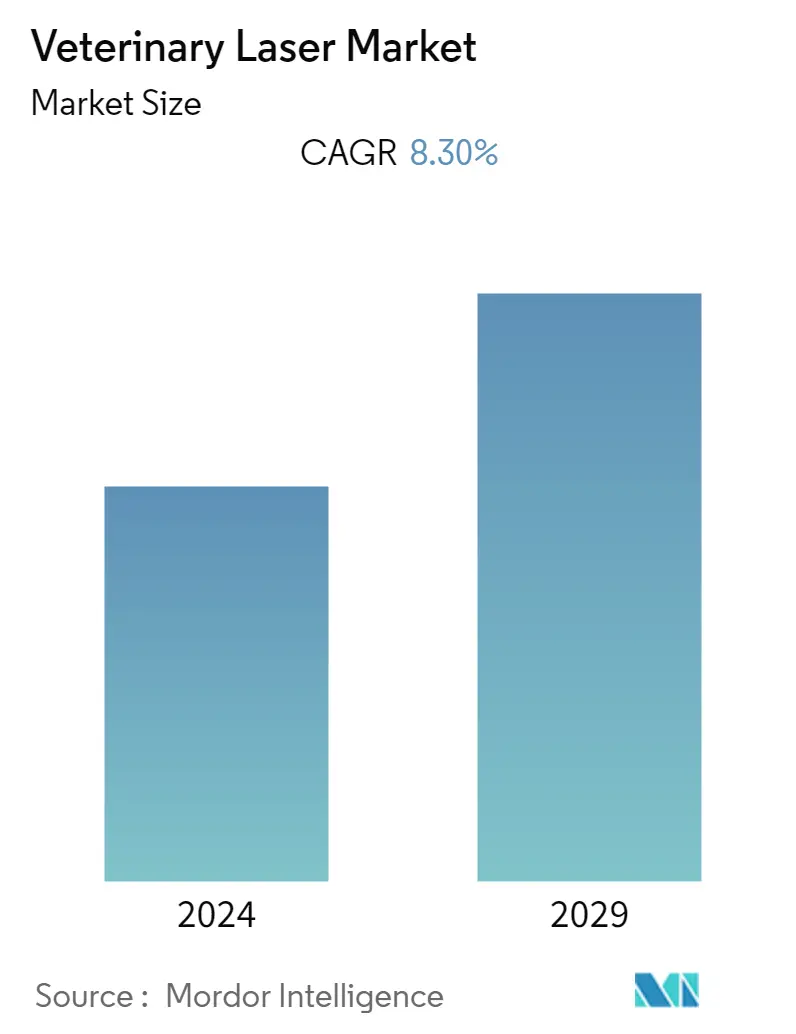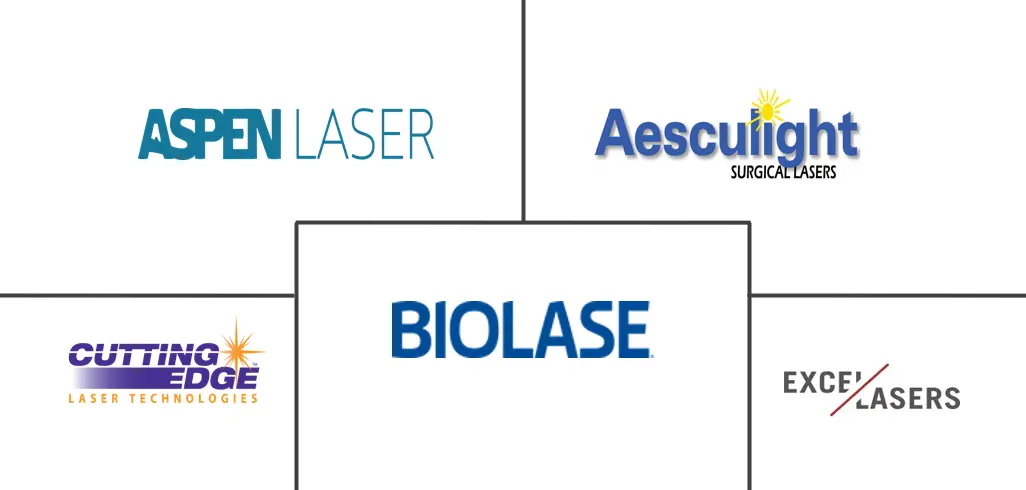Market Size of Veterinary Laser Industry

| Study Period | 2019 - 2029 |
| Base Year For Estimation | 2023 |
| Forecast Data Period | 2024 - 2029 |
| CAGR | 8.30 % |
| Fastest Growing Market | Asia-Pacific |
| Largest Market | North America |
Major Players
*Disclaimer: Major Players sorted in no particular order |
Veterinary Laser Market Analysis
Over the next few years, the veterinary laser market is expected to register an annual rate of 8.3%.
The COVID-19 pandemic had a substantial impact on the veterinary laser market. The implementation of lockdowns in several nations, as well as the corresponding limited access to and closure of veterinary facilities, led to a decline in the use of veterinary services, in turn affecting market growth. Due to the forced cancellation and reduction of veterinarian appointments, it was difficult for pet owners to avail proper veterinary treatment for their pets. For instance, as per an article published by NCBI in June 2021, the number of veterinary services in Romania was reduced by 18% during the pandemic as compared to the year 2019. It also stated that working hours were reduced in more than half of the veterinary workplaces among the surveyed population, and 18% of veterinarians received only emergency cases. This indicates that the COVID-19 pandemic was noted to have slightly slowed veterinary laser market growth.
The advancement in veterinary lasers, along with an increase in the number of pet owners, are major factors driving the demand for veterinary lasers. According to a survey published by the American Veterinary Medical Association (AVMA) in November 2021, both dog and cat populations have increased in recent years, as have the percentages of households owning dogs or cats. According to the Pet Food Manufacturers Association, as of 2021, 3.2 million households in the UK had acquired a pet since the start of the pandemic. There are now 34 million pets in the UK, including 12 million cats, 12 million dogs, 3.2 million small mammals like guinea pigs and hamsters, 3 million birds, and 1.5 million reptiles.
For instance, according to an article published in Veterinary Science in January 2021, low-level laser (light) therapy can be used in the treatment of veterinary-related orthopedics, neurology, and wound care. Furthermore, these lasers can be used to treat dermatological disorders such as hot spots, otitis externa, and non-inflammatory alopecia, among others. Thus, low-level laser therapy treatments are gaining popularity in veterinary medicine and have evolved significantly over the past decade. The laser ablates sensory nerve endings, which helps to reduce postoperative pain, according to an article published by the NCBI in March 2022 on developments in veterinary otology.Due to the growing research and development activities, the veterinary laser market is estimated to grow steadily during the forecast period.
Therefore, owing to the aforementioned factors, it is anticipated that the studied market will witness growth over the analysis period.
Veterinary Laser Industry Segmentation
As per the scope of the report, veterinary laser therapy is the process of treating an animal with the use of focused light. Unlike most light sources, the light from a laser is tuned to specific wavelengths. The veterinary laser market is segmented by product type (therapeutic lasers and surgery lasers), animal type (dogs, cats, and others), application (pain and inflammation management, regeneration or tissue repair, and others), laser type (class 2, class 3, and class 4), and geography (North America, Europe, Asia-Pacific, the Middle East and Africa, and South America). The report offers the value (in USD million) for the above segments.
| By Product Type | |
| Therapeutic Lasers | |
| Surgery Lasers |
| By Animal Type | |
| Dogs | |
| Cats | |
| Others |
| By Application | |
| Pain and Inflammation Management | |
| Regeneration or Tissue Repair | |
| Other Applications |
| By Class | |
| Class 2 | |
| Class 3 | |
| Class 4 |
| Geography | ||||||||
| ||||||||
| ||||||||
| ||||||||
| ||||||||
|
Veterinary Laser Market Size Summary
The veterinary laser market is poised for significant growth, driven by advancements in laser technology and an increasing number of pet owners. The market experienced a temporary slowdown due to the COVID-19 pandemic, which restricted access to veterinary services and reduced the number of appointments. However, the demand for veterinary lasers is rebounding as pet ownership rises and the popularity of low-level laser therapy treatments grows. These therapies are being increasingly used for various medical applications, including orthopedics, neurology, and wound care, contributing to the market's expansion. The therapeutic lasers segment, particularly cold laser therapy, is expected to see substantial growth due to its applications in minor surgeries and tissue regeneration, as well as its effectiveness in treating chronic conditions like osteoarthritis in animals.
North America holds a significant share of the veterinary laser market, supported by the presence of key industry players and a high rate of pet ownership. The region benefits from increased spending on pet care and the adoption of pet insurance, which facilitates access to advanced veterinary treatments. The market is characterized by strategic initiatives such as product launches, partnerships, and mergers and acquisitions, which are driving competition and innovation. Companies like Aspen Laser Systems LLC, Biolase Inc., and others are actively expanding their product offerings to meet the growing demand for veterinary lasers. As the market continues to evolve, these factors are expected to sustain its growth trajectory over the forecast period.
Veterinary Laser Market Size - Table of Contents
-
1. MARKET DYNAMICS
-
1.1 Market Overview
-
1.2 Market Drivers
-
1.2.1 Growing Demand for Therapeutic Lasers with Improvements in Laser Technology
-
1.2.2 Reduction of the Recovery Time and Risks Associated with Surgery
-
1.2.3 Growing Number of Severe Chronic Diseases in Animals
-
-
1.3 Market Restraints
-
1.3.1 High Costs Associated with Surgery and Lasers
-
-
1.4 Porter's Five Forces Analysis
-
1.4.1 Threat of New Entrants
-
1.4.2 Bargaining Power of Buyers/Consumers
-
1.4.3 Bargaining Power of Suppliers
-
1.4.4 Threat of Substitute Products
-
1.4.5 Intensity of Competitive Rivalry
-
-
-
2. MARKET SEGMENTATION (Market Size by Value - USD million)
-
2.1 By Product Type
-
2.1.1 Therapeutic Lasers
-
2.1.2 Surgery Lasers
-
-
2.2 By Animal Type
-
2.2.1 Dogs
-
2.2.2 Cats
-
2.2.3 Others
-
-
2.3 By Application
-
2.3.1 Pain and Inflammation Management
-
2.3.2 Regeneration or Tissue Repair
-
2.3.3 Other Applications
-
-
2.4 By Class
-
2.4.1 Class 2
-
2.4.2 Class 3
-
2.4.3 Class 4
-
-
2.5 Geography
-
2.5.1 North America
-
2.5.1.1 United States
-
2.5.1.2 Canada
-
2.5.1.3 Mexico
-
-
2.5.2 Europe
-
2.5.2.1 Germany
-
2.5.2.2 United Kingdom
-
2.5.2.3 France
-
2.5.2.4 Italy
-
2.5.2.5 Spain
-
2.5.2.6 Rest of Europe
-
-
2.5.3 Asia-Pacific
-
2.5.3.1 China
-
2.5.3.2 Japan
-
2.5.3.3 India
-
2.5.3.4 Australia
-
2.5.3.5 South Korea
-
2.5.3.6 Rest of Asia-Pacific
-
-
2.5.4 Middle-East and Africa
-
2.5.4.1 GCC
-
2.5.4.2 South Africa
-
2.5.4.3 Rest of Middle East and Africa
-
-
2.5.5 South America
-
2.5.5.1 Brazil
-
2.5.5.2 Argentina
-
2.5.5.3 Rest of South America
-
-
-
Veterinary Laser Market Size FAQs
What is the current Veterinary Laser Market size?
The Veterinary Laser Market is projected to register a CAGR of 8.30% during the forecast period (2024-2029)
Who are the key players in Veterinary Laser Market?
Aspen Laser Systems LLC, Aesculight, Cutting Edge Laser Technologies, Excel Lasers Limited and Biolase Inc are the major companies operating in the Veterinary Laser Market.

